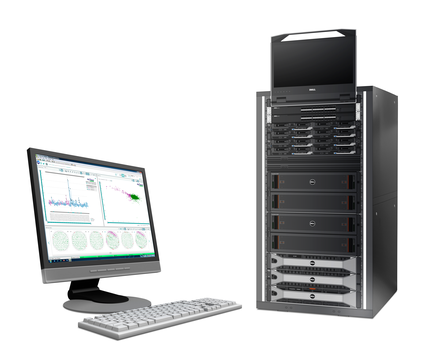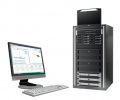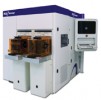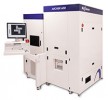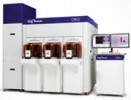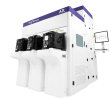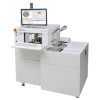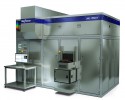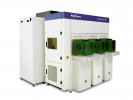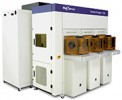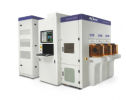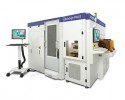Measurement Systems KLA-Tencor
DEV2019-01-15T11:44:05+07:00Measurement Systems (KLA-Tencor)
KLA-Tencor measurement system provides the different options help you choose easier with your budget.
Contact us
5D Analyzer
5D Analyzer
5D Patterning Control Solution™
Enabling real-time process control for leading edge patterning
5D Analyzer® is a run-time process control solution with supporting analytics and visualization for ≤7nm node patterning, and is a key component in KLA-Tencor’s comprehensive 5D Patterning Control Solution™. It accepts a wide range of metrology and process tool data, including overlay, reticle registration, wafer geometry, chamber temperature, films, critical dimension, and device profile metrology systems. In particular, it analyzes data from KLA-Tencor Archer™ and Crossbow™ overlay, Aleris™ and SpectraFilm™ thin film, SpectraShape™ optical critical dimension, SensArray® process temperature, WaferSight™ PWG patterned wafer geometry and LMS IPRO reticle registration metrology systems, as well as scanner data, to enable a variety of offline and real-time use cases for advanced patterning control.
- Advanced overlay analysis, characterization and real-time input to fab APC control systems for fab-wide process variations
- Real-time overlay corrections, including HOC (high order correction) and OPO (on-product overlay) corrections per exposure for optimized overlay performance
- Supports process tool data integration for fab-wide process optimization and monitoring
- Analysis and correlation of reticle data and wafer shape data to overlay
- Patterned wafer geometry module drives improved OPO by correlating wafer shape to overlay, and identifying process-induced wafer shape variations
- Scanner Data Analysis, Scanner Alignment optimization and Scanner Fleet Management improve scanner utilization and reduce yield loss
- Widely adopted by leading IC manufacturers
Aleris Family
Aleris Family
- Patented Broadband Spectroscopic Ellipsometry produces the precision, stability and matching performance required for films monitoring and thickness measurements
- Recipe sharing among different Aleris film metrology tools facilitates a flexible process control strategy within the fab that covers both high-end and low-end film applications
- Recipe Database Management (RDM) allows engineers to easily create and manage recipes remotely for a fleet for more efficient operations
- Optional StressMapper provides advanced film stress measurement capability, helping chipmakers identify process issues that can lead to cracked or delaminated films or cause overlay errors
- Reliable, extendible architecture protects fabs’ capital investments
Aleris 8330
The Aleris 8330 film metrology tool is a low cost-of-ownership solution for film thickness measurements, refractive index and stress of non-critical films, including inter-metal dielectrics, photoresists, bottom anti-reflective coatings, thick oxides and nitrides, and back end of line layers. With a 1.85x throughput increase compared to the previous generation ASET-F5x, the Aleris 8330 film thickness measurement tool provides high-throughput, reliable film measurement capability for fast identification and resolution of process issues in production.
Aleris 8350
The Aleris 8350 is a high-performance film metrology tool that meets the tighter process tolerances required for thickness, refractive index and stress measurements on critical films. The Aleris 8350 film thickness measurement tool is used for advanced film development, characterization and process control for a wide range of critical films, including ultra-thin diffusion layers, ultra-thin gate oxides, advanced photoresists, 193nm ARC layers, ultra-thin multi-layer stacks, and CVD layers.
Aleris 8510
The Aleris 8510 extends the Aleris Family’s film thickness measurements, composition, and stress measurement capability to advanced high-k metal gate (HKMG) and ultra-thin decoupled plasma nitridation (DPN) process layers. Utilizing enhanced 150nm Broadband Spectroscopic Ellipsometry technology and offering improved stability, matching and throughput relative to the Aleris 8500, the Aleris 8510 film thickness measurement tool provides engineers with the film metrology data required for development and inline monitoring of DPN layers and all HKMG layers – from gate through poly, including Hf and N dose and film thickness measurements.
Archer Series
Archer Series
Archer 600
Archer 500
Archer 500 LCM
The Archer™ 600 is a high performance optical overlay metrology system that serves as an independent source of overlay metrology data for advanced patterning processes at the 1Xnm design nodes. With enhanced imaging-based measurement technology that incorporates a new process resilient target design and improved optical systems, the Archer 600 provides best-in-class overlay control with excellent device matching for the broadest range of process layers in high volume manufacturing and leading-edge development. The Archer 600 optical overlay metrology system supports a diverse range of overlay measurement target designs, including new process-resilient ProAIM™ targets and multi-layer targets, enabling accurate overlay error measurement for different process layers, device types, design nodes and patterning technologies.
- Production-proven imaging-based measurement module includes multiple innovations that support overlay measurement on advanced IC devices, including:
- Process resilient ProAIM™ targets that closely match device behavior
- Multi-layer targets for measuring all possible combinations of layer-to-layer and within-layer overlay data from the same target image
- Multiple color filters and polarization modes enable optimal performance for every process layer with significant measurement noise reduction
- Automatic recipe optimization (ARO) reduces recipe setup time to a minimum while automatically selecting the best configuration
- Multiple process monitoring and measurement quality flags help in selecting the most robust recipes and in reducing the noise level by removing bad measurement sites
- Archer Self Calibration (ASC) enables calculation of calibrated overlay without additional measurement time to account for target inaccuracies
- Device Correlated Metrology (DCM) provides calibration of production measurements to account for differences in device and target overlay values
- Multiple illumination options enable overlay measurement capability on a wide range of lithography layers, including challenging thick resist stacks and opaque hard masks
- Reduced MAM (Move-Acquire-Measurement) time for most process layers significantly increases tool throughput and reduces system cost of ownership
- Seamless integration with 5D Analyzer®, an advanced data analysis system, provides immediate feedback on the quality of the lithography process and real-time data for scanner corrections
- Connectivity with Recipe Database Manager (RDM), a centralized database of production-proven recipe components, improves fab productivity by reducing setup time and increasing the reliability of measurement recipes
- A shared user interface with previous-generation Archer models reduces operator training time, enabling fast production integration
- Extendible platform protects a fab’s capital investment
- Advanced overlay metrology capability provides a key component for KLA-Tencor’s 5D Patterning Control Solution™, which drives optimal patterning through the characterization, optimization and monitoring of fab-wide processes
Applications
Multi-Patterning Technologies: The implementation of complex multi-patterning technologies reduces the tolerable overlay error to just a few nanometers at the 1Xnm design nodes. The Archer 600’s overlay measurement capability provides the Total Measurement Uncertainty (TMU) and accuracy needed to assess overlay performance on multi-patterning layers. Using the innovative multi-layer target, numerous combinations of layer-to-layer and intra-layer overlay data can be obtained from the same target image, requiring less measurement time and less die real estate than standard overlay targets.
In-line Monitoring: For high volume manufacturing, the Archer 600’s fast measurement speed and ProAIM™ targets produce high precision measurements, enabling quick identification of wafers with overlay error. In addition, with a wide spectral range, polarization capabilities, quality metrics and improved throughput, the Archer 600 optical overlay metrology system enables overlay measurements on a wide range of device types and process layers associated with 1Xnm device integration schemes. The overlay error data collected during production is seamlessly integrated with the 5D Analyzer analysis system to help lithographers accurately disposition wafers, reduce unnecessary wafer rework, and minimize the cycle time required to address variations in lithography tool performance. Innovative quality flags identify process changes at run time and enable fast process monitoring and excursion prevention.
Scanner Qualification: The Archer 600 optical overlay metrology system provides the high performance overlay measurement capability required to qualify scanners to improve patterning accuracy on advanced design node devices. With fast measurement speed and the use of ProAIM targets, the Archer 600 overlay metrology system can take more measurements across the wafer with higher accuracy, generating the data required to instruct the scanner to make complex, higher-order corrections. These higher-order corrections are required to manage the tighter overlay tolerances encountered at advanced design nodes.
CIRCL
CIRCL
All-Surface Wafer Defect Inspection, Metrology and Review Cluster Tool
CIRCL™ is a cluster tool with four modules, covering all wafer surfaces and providing parallel data collection at high throughput for efficient process control. The modules comprising the latest-generation CIRCL5 system include: front side wafer defect inspection; ebr metrology, profile metrology and review; back side wafer defect inspection and review; and, optical review and classification of front side defects. Data collection is controlled by DirectedSampling™, an innovative approach that uses results from one measurement to trigger other types of measurements within the cluster. The CIRCL5 tool is utilized for multiple applications within the fab, including lithography process monitoring and 3D metrology for outgoing quality control. The modular configuration of CIRCL5 offers flexibility for varying process control needs, saves overall fab space, reduces wafer queue time, and provides a cost-effective upgrade path to protect a fab’s capital investment.
8920i: Front side wafer Broad Range Inspection (BRI) module
- LED scanning technology with a selectable spectrum
- Simultaneous brightfield and darkfield optical paths to capture a wide range of defect types in a single pass
- Superior autofocus and advanced algorithms produce high capture of a wide range of defect types at < 5% nuisance rate
- Die-to-die, golden die and full wafer imaging for best defect detection
- Automated wafer defect binning and defect review provide fast identification of critical defects for reduced time to results
- Automated wafer and lot disposition for line and tool monitoring
- Macro overlay error monitoring and Reticle ID check
- Production-proven platform with high reliability, tool-to-tool matching and auto recipe setup
CV350i: Wafer edge defect inspection, profile and metrology module
- Unique, multi-channel optical design based on VisEdge® technology leverages simultaneous brightfield, darkfield and phase-contrast modes to capture a broad range of wafer edge defect types with industry-leading sensitivity
- Profile-corrected inspection ensures best signal quality and significant increase in signal-to-noise ratio for improved defect detection
- Rules-based defect classification algorithms operate on multi-channel data to minimize edge background noise and achieve high defect classification accuracy and purity
- Unique phase channel and continuous-scan design enable one-pass edge bead removal metrology measurement of the complete edge bead removal (EBR) film stack, allowing accurate characterization of coverage, concentricity and uniformity of the film edges
- Edge defect inspection and multi-layer edge metrology in the near-edge and top bevel regions of the wafer include data from patterned areas, to provide greater coverage and more accurate determination of the film edge
- Calibrated, automated edge profile measurements facilitate incoming quality control dispositioning
- Edge profile feedback to the metrology algorithm results in accurate measurement of film landing height (“z-cut”) with respect to wafer thickness on the bevel
- Simultaneous edge inspection and metrology capabilities enable comprehensive data collection from all zones comprising the wafer’s edge: top and bottom near-edge; top and bottom bevel; and apex
BDR300: Back side wafer defect inspection and review module
- Back side contamination control addresses front side defocus issues in the lithography cell and prevents chuck contamination before the wafer enters the litho track
- Significant sensitivity improvement compared to previous generation system enables clear identification of handling fingerprints at high throughput
- Brightfield and darkfield color imaging for topography and film analysis
- Fully automated color review microscope offers high resolution defect imaging for defect root cause analysis
- Advanced algorithms provide separation of defects of interest (DOI) and suppression of nuisance defects
- On-tool identification of backside fingerprint signatures drives review sampling to capture critical defects only
- Concurrent inspection and defect review produces the best cost of ownership
Micro300: Optical defect review and metrology module
- Brightfield, darkfield and differential interference contrast (DIC) optical modes enable re-detection and accurate classification of the widest range of defects
- DUV and UV optics with full autofocus capability produce high resolution imaging of defects and surrounding structures
- High throughput automated defect review reduces time-to-results for critical process decisions
- X, Y and height metrology supports multiple SpotCheck™ applications:
- Reticle ID check verifies that the correct reticle was used for printing
- Overlay error monitoring checks layer-to-layer pattern registration
- 3D shape metrology enables outgoing quality control
Applications
Process Monitor: With high throughput and a modular design, CIRCL5 provides comprehensive data for monitoring of CMP, lithography, etch, films and other processes. The use of DirectedSampling within the module results in actionable data that can accelerate root-cause determination. Furthermore, tool-to-tool matching for each module within CIRCL5 facilitates flexible WIP routing and the best baseline stability.
Lithography: CIRCL5 is ideally suited for use within the lithography cell. The front side defect inspection module captures a wide range of critical litho defects including particles, defocus defects spanning several die and full-wafer missing resist. The optical defect review and classification module provides several SpotCheck applications including Reticle ID check to verify that the correct reticle was used to print the wafer and macro overlay error monitoring to check layer-to-layer pattern registration. The back side defect inspection and review module detects contamination and scratches that can result in defocus issues when printing pattern on the wafer front side. The edge module’s inspection capability is used to detect edge defects and film delamination that could be transported to the pattern areas during immersion lithography causing yield loss. Finally, the edge module’s EBR metrology capability is used to characterize the EBR concentricity of BARC, resist and topcoat process layers in the litho stack, helping engineers to identify overlapping film edges that can lead to film delamination and increased defectivity for immersion lithography. Through high-throughput, parallel collection of multi-surface wafer data, CIRCL5 enables lithography engineers to quickly identify critical issues and take fast corrective action to prevent yield loss.
Outgoing Quality Control (OQC): CIRCL5 provides 3D macro wafer shape metrology, enabling outgoing quality control for advanced packaging. In addition to front side wafer defect inspection, wafer edge inspection and edge metrology, CIRCL5 measures X, Y and height (Z) for complete characterization of PAD layers.
Crossbow Series
Crossbow Series
Overlay Metrology Systems
The ATL™ (Accurate Tunable Laser) is a high performance scatterometry-based overlay metrology system designed to meet the required accuracy and process robustness needs for overlay control at the 7nm node and beyond. Tunable laser technology with 1nm resolution paired with a real-time homing algorithm maintains overlay accuracy and process robustness for leading-edge development and high volume manufacturing. The ATL optical overlay metrology system supports a diverse range of scatterometry overlay measurement target designs, including in-die and small pitch, enabling accurate overlay error measurement for different process layers, device types, design nodes and patterning technologies.
- Production-proven scatterometry-based system includes multiple innovations that support overlay measurement on advanced IC devices, including:
- Tunable laser technology with 1nm resolution enables high accuracy overlay measurements for fast technology ramps and improved yield performance
- High intensity light source enables narrow bandwidth required for maintaining robust and accurate overlay measurements when challenged with process variation
- Homing™ automatically maintains both on product overlay and accuracy stability to produce process robust overlay measurements
- On-the-fly pupil data provides indications of process variation during production runs and enables flags for real-time monitoring
- Automatic recipe optimization (ARO) reduces recipe setup time to a minimum while efficiently evaluating and ranking recipe configurations for the best accuracy
- Reduced MAM (Move-Acquire-Measurement) time significantly increases tool throughput and reduces system cost of ownership
- Seamless integration with 5D Analyzer®, an advanced data analysis system, provides immediate feedback on the quality of the lithography process and real-time data for scanner corrections to improve CPk for HVM and enable fleet management for ARO and Homing
- Connectivity with Recipe Database Manager (RDM), a centralized database of production-proven recipe components, improves fab productivity by reducing setup time and increasing the reliability of measurement recipes
- Built on the combo ready and extendible CrossbowTM platform to provide future upgradability while protecting a fab’s capital investment
Applications
In-line Monitoring: For high volume manufacturing, the ATL’s fast measurement speed and tunable laser technology with Homing™ produce accurate and robust overlay measurements, enabling quick identification of wafers with overlay error. On-the-fly pupil data provides indications of process variation during production runs and enables flags for real-time monitoring on a wide range of device types and process layers associated with 7nm device integration schemes. The overlay error data collected during production is seamlessly integrated with the 5D Analyzer analysis system to help lithographers accurately disposition wafers, reduce unnecessary wafer rework, and minimize the cycle time required to address variations in lithography tool performance. Innovative quality flags identify process changes at run time and enable fast process monitoring and excursion prevention.
Scanner Qualification: The ATL scatterometry-based overlay metrology system provides the high performance overlay measurement capability required to qualify both 193i and EUV based scanners to improve patterning accuracy on advanced design node devices. With fast measurement speed and the use of small in-die targets, the ATL overlay metrology system can take more measurements across the wafer with higher accuracy, generating the data required to instruct the scanner to make complex, higher-order corrections. These higher-order corrections are required to manage the tighter overlay tolerances encountered at advanced design nodes.
Patterning Control: The ATL provides accurate and robust overlay measurements for advanced design nodes and is a key component in KLA-Tencor’s 5D Patterning Control Solution™ which allows fabs to characterize, optimize and monitor fab-wide patterning processes using high-performance metrology systems and advanced data analysis.
HRP-260
HRP-260
Surface Topography Profiling
Product Description
The HRP-260 is an automated, advanced surface topography metrology tool, featuring high resolution/high-aspect ratio, stylus-based surface topography profiling for leading edge 200mm applications. This surface topography metrology tool’s ultra-fine 20nm stylus tip option enables down to 45nm-generation surface topography profiling at cost-effective throughputs for critical transistor and interconnect applications. Featuring diamond styli down to 20nm radius and a lower-noise platform for enhanced measurement sensitivity, the HRP-260 surface topography profiling system offers nanometer-scale stylus technology which matches AFM resolution – without modeling requirements. In addition to the 200mm HRP-260 surface topography profiling system, a 300mm HRP-350 surface topography metrology system is also available for IC semiconductor manufacturing applications.
Applications
- High-resolution mode enables accurate control of nano-scale features for applications that directly impact device performance, such as Shallow Trench Isolation, CMP in the interconnect, metal film roughness and tungsten plug recess.
- Long-scan mode operates at high throughput to measure Cu CMP dishing and erosion, copper plating, die planarity, and C4 bump height in packaging.
LMS IPRO Series
LMS IPRO Series
LMS IPRO7
LMS IPRO6
LMS IPRO5
Product Description
The LMS IPRO7 mask registration metrology tool is designed to accurately verify pattern placement performance of reticles for the 7nm node. It offers comprehensive characterization of reticle pattern placement error, which is a direct contributor to intra-field wafer overlay error. As several papers indicate1, due to different mask registration performance of targets and on-device features, it is mandatory to characterize the reticle contribution to intra-field wafer overlay on on-device patterns. KLA-Tencor’s proprietary model-based metrology algorithm allows the LMS IPRO7 mask metrology system to accurately measure placement error for on-device pattern features, and thus characterize real mask contribution to intra-field overlay.
Based on the industry-proven IPRO platform, the LMS IPRO7 mask registration metrology system achieves its industry-leading performance by incorporating several new or improved features:
- New operating mode provides highly accurate on-device measurement of reticle registration error with industry-leading cycle time for comprehensive reticle qualification
- Significantly improved measurement performance over the LMS IPRO6 enables development and production of reticles at the ≤7nm design node
- Fast and accurate model-based image processing algorithms for on-device pattern metrology to detect and characterize pattern dependent placement error
- Optical resolution enables measurement of all immersion masks and development and production of EUV masks
- Registration measurement on 193i reticles with and without pellicles
- High-throughput mode enables more comprehensive reticle and e-beam qualification at the same cycle time for production masks
- Registration metrology on resist test masks enables feed forward of mask registration data to 5D Analyzer® for optimized intra-field scanner corrections
- Automated pattern selection from design capability allows for easy generation of on-device measurement jobs with 1000 or more OPC’ed sites
- Field-proven EUV mask capability for 7 nm node development
- Field upgradability from the previous generation model protects customer’s capital investment
Applications
Mask writer qualification and monitoring: Today’s mask writers are able to incorporate sub-nm pattern placement corrections. In order to take advantage of this capability, pattern placement error must be measured accurately with high sampling frequency. LMS IPRO7 supplies the automation performance, high throughput, and analytical software needed to fully characterize reticle pattern placement error. Based on these data the performance of the mask writer can be verified and adjustments performed if required, so that fewer problems are discovered at outgoing quality control (OQC).
Mask process development and monitoring: LMS IPRO7 is the only mask registration metrology system to offer flexible, automated on-device metrology, industry-leading performance, and the ability to take through-pellicle (193i masks) measurements. In order to envision and correct pattern dependent registration error, the LMS IPRO7 provides accurate measurement capability on actual on-device features.
Furthermore, the LMS IPRO7 is the only DUV illumination-based registration tool which enables measurement on resist masks in order to separate e-beam error from process deviations.
Wafer patterning control: As part of the 5D Patterning Control Solution™, LMS IPRO7 reticle data can be directly uploaded to the industry standard 5D Analyzer software to assess the mask’s contribution to wafer overlay error. Thus, on-device data can be fed forward to the wafer fab’s lithography module and used for optimized scanner corrections that can improve intra-field wafer overlay yield.
RS-100
RS-100
Advanced Resistivity Metrology
Product Description
The RS-100 resistivity measurement system is a production worthy tool used in nearly all fabs worldwide. This resistivity measurement system provides capabilities such as advanced automation and improved edge performance to meet today’s production requirements for 300mm wafers.
- Accurate and repeatable resistivity measurements to 1mm from the conductive film edge gives enhanced performance for both 200mm and 200mm wafers
- Patented temperature compensation provides the accuracy, long-term repeatability, and system-to-system/fab-to-fab matching for today’s production requirements
- Powerful, easy to use Windows NT-based software enables true multi-tasking capabilities
Application
Metal deposition, CMP, ion implantation and diffusion
Enhanced Edge Performance Leading the industry, the RS-100 is the first resistivity measurement system with enhanced edge performance, collecting resistivity information up to 1 mm from the conductive film edge. Not only does this additional information provide greater insight to process control variance, it extends a wafer’s useable area, lowering cost-of-ownership. The RS-100 resistivity measurement system’s innovative approach to wafer alignment also improves the probe placement accuracy and repeatability over existing systems.
Powerful, Easy-to-Use Software Operating on Windows NT
RS-200
RS-200
Accurate Sheet Resistance Measurements
Product Description
The RS-200 resistivity mapping system based on proven industry resistivity mapping standards provides accurate and reliable sheet resistance measurement for 45 nm and beyond. This resistivity mapping system provides capabilities such as advanced automation and improved edge performance to meet today’s production requirements for 300mm wafers.
- The resistivity mapping system’s accurate and repeatable sheet resistance measurements to 1mm from the conductive film edge provides enhanced performance for both 200mm and 300mm wafers
- Patented temperature compensation provides the accuracy, long-term repeatability, and system-to-system/fab-to-fab matching for today’s production requirements
- The RS-200 resistivity mapping system includes easy-to-use software based on the Windows XP operating system, enabling faster recipe set-up and data analysis
SpectraFilm Family
SpectraFilm Family
Film Metrology System
- SpectraFilm F1
- SpectraFilm LD10
The SpectraFilm™ F1 film metrology system helps chipmakers achieve strict process tolerances at sub-7nm logic and leading-edge memory design nodes by providing high-precision thin film measurements for a broad range of film layers including advanced multilayer film stacks like high-k metal gate. The high brightness light source drives the SpectraFilm F1’s spectroscopic ellipsometry technology and enables characterization and monitoring of advanced film stacks, while providing the signal required to accurately measure the bandgap and provide insight into electrical performance weeks earlier than e-test. New FoG™ (Films on Grating) algorithms further increase the measurement’s correlation to device by enabling film measurement on a device-like grating structure. With increased throughput, the SpectraFilm F1 film metrology system offers high productivity, supporting the increased number of film layers associated with multi-patterning and other leading-edge device fabrication techniques.
- New spectroscopic ellipsometer enables the precision, stability and matching performance required for monitoring advanced films and film stacks using several optical technologies, including:
- Laser sustained plasma light source, providing higher intensity and lower noise for greater sensitivity and improved stability on a broad range of materials
- Multiple angles of incidence provide flexibility for high accuracy across a range of applications therefore reducing the need for DFF solutions
- Polarization capability provided by novel polarizer and compensator technology provides additional measurement flexibility for higher sensitivity to critical film parameters on device-like grating structures
- Optional Infrared Spectroscopic Ellipsometer (IRSE) supports film measurements on the thick, multi-layer film stacks used in 3D NAND flash devices and other film layers such as high absorption amorphous carbon hard masks
- SWEep (single wavelength ellipsometer) incorporates a new laser and other improved optical elements to enable advanced matching on ultra-thin films
- New Laser Driven Spectroscopic Reflectometer with unique TruNI™ illumination technology, enables the best sensitivity and accuracy for challenging applications, such as Films on Grating (FoG)
- New algorithms provide improved metrology-to-device correlation:
- Bandgap metrology on planar pads and grating structures
- FoG engine supporting film stack measurements on grating structures
- New stage design and the laser sustained light source enable higher throughput compared to predecessor models allows chipmakers to measure more film layers or to increase sampling, resulting in improved films process control
- Recipe Database Management (RDM) allows engineers to easily create and manage recipes remotely for a fleet for more efficient operations
- Recipe porting from Aleris and SpectraFilm LD10 to SpectraFilm F1 facilitates a flexible process control strategy within the fab and speeds production integration of the new SpectraFilm F1 platform
- Reliable, extendible architecture protects fab’s capital investments
- Laser sustained plasma light source allows a longer duration between preventative maintenance (PM) activity compared to previous light sources
Applications
Multi-Layer Thin Films: Advanced high-k metal gate stacks consist of multi-layer thin films, with materials such as high-k dielectrics, interfacial layers and metal films. With the new, laser sustained plasma light source and multiple angles of incidence, the SpectraFilm F1 provides thin film measurement capability beyond traditional SE systems. Supporting both development and production, the SpectraFilm F1 enables precise control of individual films in a multi-layer thin film stack reducing the need for DFF.
Films on Grating: The FoG algorithms in combination with the novel compensator and the spectroscopic reflectometer supports measurement of advanced films and film stacks on gratings while maintaining the required precision, stability and matching performance. FoG measurements provide improved device correlation and the flexibility to remove large planar pads from advanced node scribe lanes.
Bandgap Metrology: The bright laser sustained plasma light source of the SpectraFilm F1 allows for a high resolution measurement of the bandgap during the high-k metal gate process. This measurement can predict electrical performance such as leakage current weeks before electrical test and provides an additional process correctable during the high-k metal gate process that can be tuned to maximize device performance.
Patterning Control: SpectraFilm F1 provides advanced node thin film measurements and is a key component in KLA-Tencor’s 5D Patterning Control Solution™, which allows fabs to characterize, optimize and monitor fab-wide patterning processes using high-performance metrology systems and advanced data analysis.
SpectraShape Family
SpectraShape Family
Optical Critical Dimension (CD) and Shape Measurement Systems
- SpectraShape 10K
- AcuShape
- SpectraShape 9000
- SpectraShape 8000 Series
Product Description
The SpectraShape™ 10K dimensional metrology system is used to fully characterize and monitor the critical dimensions (CD) and three dimensional shapes of FinFETs, vertically stacked NANDs and other complex features on integrated circuits at the 1Xnm design nodes and beyond. Using a diverse array of optical technologies and patented algorithms, the SpectraShape 10K optical CD and shape measurement system provides feedback on critical device parameters (e.g. critical dimension, metal gate recess, high k recess, side wall angle, resist height, hard mask height, pitch walking) for a broad range of applications across the IC fab, from the early layers of leading-edge transistors to the last interconnect layers.
- New spectroscopic ellipsometer enables high accuracy measurement of critical parameters for complex device structures using several optical technologies, including:
- Laser driven plasma light source, providing higher intensity and lower noise for higher sensitivity and improved stability on a broad range of materials and structures
- Multiple angles of incidence provide flexibility for high accuracy across a range of applications
- Polarization capability provides additional measurement flexibility for higher sensitivity to critical device parameters
- New Laser Driven Spectroscopic Reflectometer with unique TruNI™ illumination technology, enables the best sensitivity and accuracy for challenging applications, such as FinFET structures
- Optional infrared channel enables high sensitivity for vertical memory applications
- Superior repeatability, reproducibility, matching and reliability enable characterization of small process variations that affect device performance
- Target-based, non-destructive optical measurements provide 3D profile information without costly wafer cross-sections
- New, smaller box size supports multi-patterning lithography and smaller scribe lanes
- Reduced measurement time compared to the previous-generation SpectraShape 9000 systems supports the increased sampling required for tighter process control and the growth in number of process layers due to multi-patterning
- AcuShape 3 Series software package accelerates the process of building robust, usable 3D shape models
- Reliable, extendible architecture protects a fab’s capital investment
AcuShape 3 Series is the advanced modeling software that interprets the signals from the SpectraShape 10K systems. AcuShape 3 Series accelerates the process of building robust, usable 3D shape models. It includes a flexible user interface that enables model building by fab engineers with or without assistance from outside experts. Innovative algorithms speed library generation, ensure library quality and provide new visualization options. Additional AcuShape 3 Series features, such as Model Optimizer Plus and Auto Subsystem Selector which automates the modeling process, help accelerate time to a reliable solution.
Applications
Gate Monitor: Advanced gate processes, such as high k metal gate technologies, FinFETs, and high aspect ratios in vertically stacked NANDs and flash devices feature more complex device structures and require control of a greater number of measurement parameters. The SpectraShape 10K optical CD and shape measurement systems produce a detailed description of the shape of gate structures and identify any deviations beyond allowed tolerances. SpectraShape 10K systems measure parameters (e.g. critical dimension, metal gate recess, high k recess, side wall angle, resist height, hard mask height, pitch walking) critical to understanding and controlling the gate process before and after etch.
BEOL Dual Damascene: For back end of line dual damascene processes, small modulations in parameters, such as the bottom diameter of dual-damascene contacts, can seriously impact device yield or reliability. The SpectraShape 10K optical CD and shape measurement systems are used to obtain a comprehensive understanding of trench and contact profiles, providing engineers with a high productivity solution for identifying and monitoring process excursions.
Patterning Control: SpectraShape 10K systems measure and monitor CDs for self-aligned patterning (SADP, SATP, SAQP) and multi-patterning (litho-etch-litho-etch) techniques.
Surfscan Series
Surfscan Series
Unpatterned Wafer Surface Inspection Systems
- Surfscan SP5XP
- Surfscan SP5
- Surfscan SP3
Product Description
The Surfscan® SP5XP unpatterned wafer inspection system and wafer qualification tool is a platform extension of the Surfscan SP5, enabling lower cost of ownership for 1Xnm design rule High Volume Manufacturing (HVM). The Surfscan SP5XP can operate at sensitivity similar to that of the Surfscan SP5, but at much higher throughput, enabling increased sampling for a lower cost of ownership. Additionally, the Surfscan SP5XP provides higher available sensitivity on bare wafers and blanket films than that of the previous-generation Surfscan SP5, delivering the inspection performance required for IC manufacturers to qualify processes during R&D. The Surfscan inspector also includes an integrated, high resolution SURFmonitor module that characterizes and measures surface quality, helping IC modules qualify their process and tools by characterizing wafer surface quality and detecting subtle defects.
- Powerful DUV source, incident laser innovations, new spot sizes and improved algorithms deliver sub-20nm sensitivity, increased throughput and enhanced defect detection and classification
- Platform improvements produce the highest throughput-to-date on the Surfscan platform
- Dual Threshold operates without throughput loss, allowing fabs to maintain their baseline while investigating the possible presence of new defect types and signatures
- Attenuated Continuous Laser Power Attenuation (ACLPA) feature enables variable laser power in a single scan, allowing the system to maintain sensitivity without throughput loss
- Laser power dosage test wizard enables faster recipe setup on laser power sensitive layers
- New and improved algorithms enable enhanced signature detection and classification with no baseline change and no throughput loss
- Matching between Surfscan SP5XP tools improves factory productivity by providing fabs with the option of routing WIP to different Surfscan SP5XP inspection tools to optimize work flow
- Correlation of Surfscan SP5XP to Surfscan SP5 and SP3 baselines enhances fleet flexibility, allowing fabs to mix-and-match tools based on their unique sensitivity and throughput requirements
- Field upgradeable from the Surfscan SP5 protects a fab’s capital investment
- Flexible configurations support the specific performance requirements of different end-users
Integrated SURFmonitor is a defect/metrology module that utilizes background scattering (haze) data from Surfscan SP5XP scans to monitor process signatures and low contrast defects, without affecting inspection throughput. SURFmonitor can correlate haze to process parameters such as surface roughness and grain size, serving as a high speed, full-wafer metrology proxy for bare wafers and blanket films.
Applications
IC Manufacturing
Process Tool Monitoring: Within the IC fab, the Surfscan SP5XP is used for qualification and monitoring of process tools for the 1Xnm design node HVM. The extended DUV sensitivity captures tiny blanket film defects at production speeds, enabling engineers to monitor process tools for defects that may be introduced during film deposition or CMP.
R&D: The high sensitivity operating mode on the Surfscan SP5XP supports characterization and qualification of new processes during the R&D phase of IC manufacturing. With strong connectivity, the Surfscan SP5XP and KLA-Tencor’s e-beam review tool provide development engineers with a solution for quickly finding, identifying and sourcing critical defects on leading-edge processes.
Incoming Wafer Qualification: The extended DUV sensitivity of the Surfscan SP5XP helps IC manufacturers ensure that incoming wafers meet their strict wafer quality specifications.
Equipment manufacturing
Process tool qualification: Defects added by the tool during processing, such as fall-on particles or metal contamination, can adversely affect wafer yield or device performance. Certain process steps like polishing can worsen the wafer surface quality and create anomalous process defect signatures that may render the wafer unsuitable for further processing. Early detection and classification of these subtle conditions is critical to ensure optimal yield. The Surfscan SP5XP’s extended DUV sensitivity and high-resolution SURFimages provide key information, enabling equipment vendors to build reliable, production-worthy process tools.
Process uniformity monitor: The full-wafer high-resolution SURFimage represents the variations of the wafer surface quality in response to changes in process chemistries or recipes, enabling process optimization and production monitoring. Dark field haze calibration ensures that the haze readings are accurate and repeatable across tools.
Thermo-Probe Series
Thermo-Probe Series
Implant Metrology Systems and Micro-Uniformity Maps
- Therma-Probe 680
Product Description
The Therma-Probe 680 is a high performance, reliable implant metrology tool, enabling inline dose monitoring for the full range of implant and anneal applications at the 2Xnm/1Xnm design nodes. Continuing as the industry standard for implant metrology and anneal metrology, the Therma-Probe 680 produces critical process information about implant dose and profile, implant and anneal uniformity and end-of-range damage. In addition, the Therma-Probe 680’s high-resolution micro-uniformity maps provide fingerprinting capability for implant and anneal process development.
- New UV laser source provides metrology capability for the full range of energy/dose implant applications and for advanced anneal applications
- High-resolution micro-uniformity map reveals previously unknown uniformity issues
- A throughput increase of >20% over the previous-generation Therma-Probe 630XP enables higher sampling for tighter process control
- Production-proven tool-to-tool matching enables production efficiency and facilitates fab-to-fab technology transfers
- High reliability and availability support IC ramp and production
Application
Implant Metrology: The Therma-Probe 680 metrology system provides inline dose monitoring for a full range of implant applications. Medium current, high energy implant applications supported include: pocket, In or Sb channel, well, triple well and CCD buried barrier. Examples of high current, ultra-high dose implant applications supported by the Therma-Probe 680 include: ion beam mixing, band gap engineering, gate doping, PAI, source/drain and extension. In addition, the Therma-Probe 680 can measure ultra-shallow junction (USJ) depth and provide end-of-range detection.
Anneal Metrology: The Therma-Probe 680 supports process development and inline monitoring of the full range of anneal applications, from bulk heating anneal processes (e.g. furnace, RTP) to higher temperature, diffusionless annealing processes (e.g. flash, laser, spike). For laser anneal processes, the micro-uniformity map produced by the Therma-Probe 680 can expose previously unknown process uniformity issues related to scanning mode, scanning pitch, scan stitching or laser spot distribution. For all annealing processes, the Therma-Probe provides non-destructive, inline feedback on the quality of the process, allowing engineers to take quick corrective action when issues arise.
WaferSight PWG
WaferSight PWG
Wafer Geometry and Nanotopography Metrology Systems
- WaferSight PWG2
Product Description
The WaferSight™ PWG2 (Patterned Wafer Geometry) metrology system enables patterned wafer geometry control for the 1Xnm design nodes. Built on the production-proven WaferSight platform, it is a single-tool solution for measuring stress-induced wafer shape changes, wafer shape-induced overlay, wafer thickness variations and wafer front- and backside topography. With significantly increased productivity compared to its predecessor, the WaferSight PWG2 delivers increased wafer sampling in production for in-line monitoring of processes such as thin films, etch, anneal and other modules – enabling faster yield ramp, overlay control, and lithography focus window control.
WaferSight PWG2 is a key product in KLA-Tencor’s 5D™ Patterning Control Solution™, which drives optimal patterning through the characterization and monitoring of fab-wide processes. Through close integration with KLA-Tencor’s 5D Analyzer® data analysis system, WaferSight PWG2 data is utilized in feedback and feed forward modes. The WaferSight PWG2’s comprehensive wafer stress and shape uniformity data can be fed back to fab processes, helping chipmakers identify and fix process variations that can cause patterning and yield issues. This same data can also be fed forward to the lithography module, allowing engineers to understand whether overlay errors caused by wafer shape variations can be compensated for by using current scanner controls. Because 5D Analyzer can also calculate overlay issues that are not related to wafer shape, engineers can use this data analysis system to combine shape and non-shape overlay corrections into a single scanner correction file for improved litho performance.
WaferSight PWG Measurement Capability
The WaferSight PWG2’s industry-unique vertical wafer hold enables full measurement of both the wafer’s front side and backside without gravitational distortion effects. This allows calculation and/or detection of:
- Wafer shape variation
- In-plane displacement
- Stress-induced local curvature
- Wafer thickness and flatness variation
- Front and back surface Nanotopography (NT)
- Wafer edge roll-off (ERO)
- Sliplines
Applications
Process Monitoring: The WaferSight PWG2 produces comprehensive wafer stress and shape uniformity data, enabling process tool monitoring and matching for film deposition, anneal, etch and other process modules. The WaferSight PWG2’s proven metrics help reduce process development time through faster root cause determination. In addition, the WaferSight PWG2’s productivity improvements promote increased wafer sampling in production, helping chipmakers identify and fix process-induced wafer stress variations that can result in significantly reduced process windows. In high volume manufacturing, the WaferSight PWG2 helps optimize and monitor a wide range of fab processes, and supports fab applications such as:
- Process optimization and in-line monitoring to control wafer shape variations for film deposition and RTP processes
- Chamber matching of film deposition tools such as CVD processes
- In-line monitoring of local stresses within a wafer arising from film deposition processes for vertically integrated devices, such as 3D NAND flash
- In-line monitoring of CMP processes for wafer flatness and/or NT, thereby reducing scanner defocus at downstream litho operations
Lithography Control: The WaferSight PWG2’s wafer shape data from pre-litho fab processes can be fed forward to the scanner to address overlay errors due to wafer stress – a particular concern for 3D NAND devices, which utilize thick film stacks that can distort wafers. In addition, the WaferSight PWG2 generates wafer flatness and topography metrics that can improve prediction and control of scanner focus. With rapidly shrinking overlay and focus process windows for 1Xnm and below design nodes, the WaferSight PWG2 can play a key role in expanding litho process windows through:
- Identification of sources of higher order shape component of lithography overlay residuals otherwise not correctable by scanner. WaferSight PWG2 uses wafer backside measurements for such calculations, thus eliminating pattern effects from the wafer’s front side
- Qualifying scanner chuck flatness variation
- In-line monitoring of non-litho processes for wafer flatness and/or NT, thereby reducing scanner defocus at downstream litho operations
- Qualification and in-line monitoring of ERO characteristics impacting scanner depth of focus (DOF) budget at the wafer’s near-edge region


